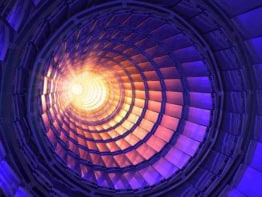Astrophysicists expect their best-ever view of remote cataclysmic events that send neutrinos cascading across space after the successful trial of a new neutrino detector. Francis Halzen of the University of Wisconsin in the US led the international team that developed the experiment, which is buried deep in the Antarctic ice. The prototype is now being scaled up to capture neutrinos arriving on Earth from deep space (E Andrés et al 2001 Nature 410 441).

Neutrinos are fundamental particles with very low mass and no electric charge. They can travel enormous distances across the Universe – carrying information about their sources – because they barely interact with matter. Low-energy neutrinos from the Sun have already been observed in small detectors. But high-energy neutrinos from cosmic sources are extremely difficult to spot, and detectors must be very large to pick up them up.
The ‘Antarctic muon and neutrino detector array’ – AMANDA – spans a cylindrical volume of ice 500 metres deep and 120 metres in diameter, and is buried 1.5 kilometres beneath the surface. As neutrinos travel through the ice they collide with nucleons – protons and neutrons – within the ice and surrounding rock. These collisions create muons, heavier cousins of the electron, which emit blue and ultraviolet light as they travel through the ice. This light is ‘Cerenkov radiation’, which is emitted by all charged particles travelling faster through a medium than the speed of light in that medium.
AMANDA’s 302 photomultipliers detect the Cerenkov radiation to reveal the ‘decay path’ of the muon, and in turn, information about the neutrino and its source. The experiment collected more accurate data in 138 days than existing experiments had gathered over much longer periods. “We are already working hard to scrutinize the data for signs of any astrophysical phenomena – from gamma-ray bursts to dark matter or magnetic monopoles”, Halzen told PhysicsWeb.
The experiment successfully captured muons created by high-energy neutrinos travelling ‘upwards’ through the ice, which must have passed through the Earth. It filtered out ‘downward’ muons created by cosmic ray interactions in the atmosphere rather than by neutrinos. Now that the technique has been proved, Halzen’s team plans to build a much larger detector to pick up more neutrinos from deep in the Universe. The ‘IceCube’ experiment will spread 4800 photomultipliers over a square kilometre.
“Whenever a new instrument for studying the sky is launched, unexpected discoveries are made – and they are invariably more interesting than what had been anticipated”, Halzen says. “We very much hope to continue this trend”.



